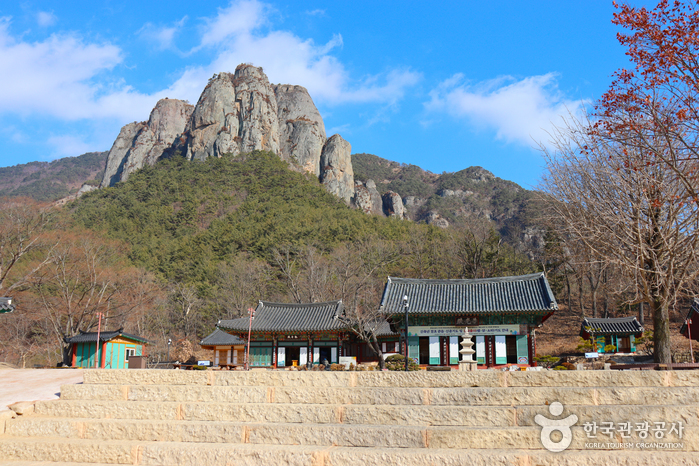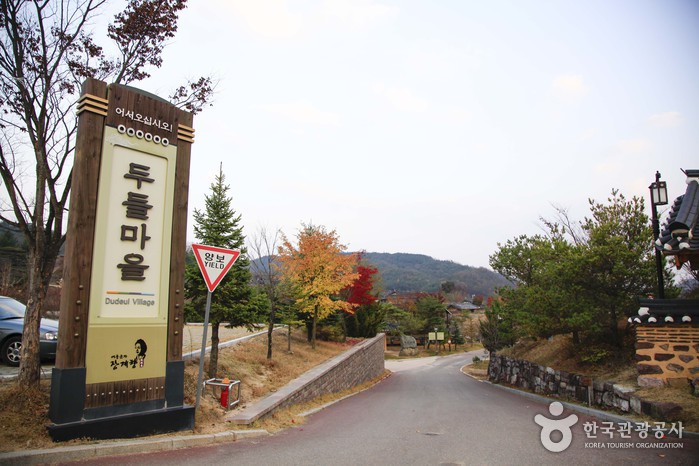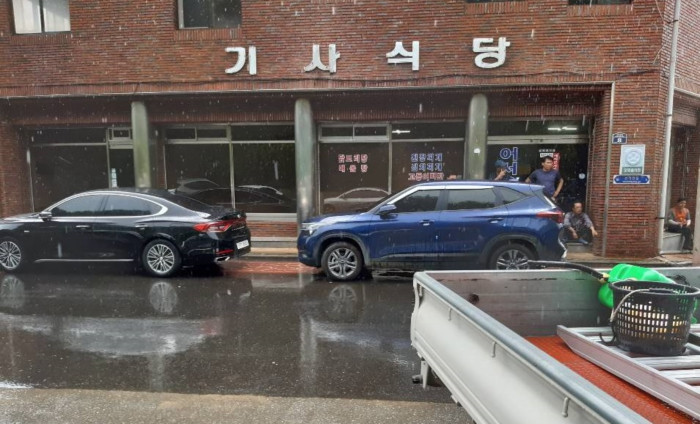Daejeonsa Temple (대전사)
12.9 Km 13481 2023-04-17
226, Gongwon-gil, Cheongsong-gun, Gyeongsangbuk-do
+82-54-873-2908
Daejeonsa Temple is said to have been built by Great Monk Uisang in the 12th year of King Munmu’s reign (672). It was rebuilt in the 13th year of King Hyeonjong’s reign (1672) after a fire destroyed the original temple complex during the Imjin War (1592-1598). During work to renovate Bogwangjeon Hall in 1976, a text that had been put up with the ridge beams was found. Bogwangjeon Hall is a small building and its ceiling is in the shape of a Chinese character that symbolize with the meaning "well" or "pavilion" that looks similar to the sharp(#) symbol. A Birojanabul Buddhist statue is enshrined in the hall.
Three Falls of Juwangsan Mountain (주왕산 1.2.3 폭포)
13.3 Km 38475 2024-02-13
24 Sangui-ri, Juwangsan-myeon, Cheongsong-gun, Gyeongsangbuk-do
Above Haksodae Cliff in Juwangsan Mountain lie three enchanting waterfalls. The first of these falls goes by the name of Yongchupokpo Falls, where water gracefully meanders through a gorge, enveloped by encircling rocks. Roughly one kilometer further upstream, you'll encounter Jeolgupokpo Falls, accompanied by the tranquil Seonnyeotang Pond below. To the left of Jeolgupokpo Falls stands the grandeur of Yongyeonpokpo Falls, the largest and most magnificent among them. Yongyeonpokpo Falls is also famously referred to as Ssangyongchupokpo Falls, denoting its two distinct torrents of water ('ssang' meaning 'two,' and 'yongchu' signifying 'pond' in Korean). A well-maintained trekking path welcomes visitors, allowing them to explore and ascend to witness these three falls, with a gentle incline that is easily traversed by visitors of all ages.
Suaedang [Korea Quality] / 안동 수애당 [한국관광 품질인증]
13.7 Km 71642 2023-10-23
1714-11 , Sugogyonggye-ro, Andong-si, Gyeongsangbuk-do
+82-54-822-6661
Suaedang House in Andong, Gyeongsangbuk-do, was built in 1939 by independence activist Soo Ae Yu Jin-geol, and is a Gyeongsangbuk-do cultural asset. The hipped-and-gabled pavilion and the ㄱ-shaped gobangchae (female servants’ quarters) face each other across the courtyard, and the house has a 10-metre lofty gate. Suaedang was moved to its current location in 1987 due to the construction of the Imha Dam. The room and Daecheongmaru are red clay-walled and natural painted. The view of the lake from Suaecang is very beautiful.
YeongYang Doodle Village (영양 두들마을)
14.5 Km 20567 2020-02-10
62, Dudeulmaeul-gil, Seokbo-myeon, Yeongyang-gun, Gyeongsangbuk-do
+82-10-7373-8337
Located in the administrative district of Wonri-ri, Seokbo-myeon, Yeongyang-gun, Gyeongsangbuk-do, Doodle Village's name means ‘village on a hill’ in Korean. In 1640, Lee Sim-yeong who used the pen name Seokgye, decided to build the village as an escape during the second Manchu invasion in Korea. His descendants, the family of Lee Jae-ryeong have lived and continued to build up the village since his settlement. In the year 1899 during the Joseon dynasty, Gwangjewon, the national hospital back then, was also established nearby. After the last syllable of Gwangjewon, the village was also called Wondoodle or Wonri
The village master, Seokgye, lived in his own house called Seokgye Gotaek (old Hanok house) and Seokgye Seodang, a private learning institute where he taught his students. The village also treasures many cultural heritages including 30 houses, a memorial stone for Madam Jang's first cookbook written in Hangeul (Korean alphabet) and Gwangsan Literature Laboratory, set up by famous writer Lee Mun-yeol.
Hwamaecheon Stream wraps around the village and on the rocky cliff hugging the stream, the fourth son of Master Seokgye set up Dongdae, Seodae, Nakgidae, and Sesimdae.
The village was designated as a cultural village in 1994 by the government.
Jeongjae Head House [Korea Quality] / 정재종택 [한국관광 품질인증]
14.7 Km 7778 2023-10-24
2661-8 , Gyeongdong-ro, Andong-si, Gyeongsangbuk-do
+82-54-822-6205
Jeongjae Head House is the head house of Joseon scholar Jeongjae Ryu Chi-myeong, a colleague of the famous Toegye Lee Hwang. The house overlooks Imha Lake in Andong-si, Gyeongsangbuk-do, and is 300 years old. The long endurance of the stone foundations, roof tiles and wooden beams and porch gives the place a solid, calming feel. The house consists of a daemunchae (gate house) jeongchim (square-shaped building), haengnangchae (servants’ quarters), sadang or shrine, and a pavilion called Manujeong which houses a lecture hall but can also be used for lodging. Guests can learn how to brew songhwaju spirit and tarak fermented milk liquor, and listen to gayageum or folk song performances.
Imhaho Gisa Sikdang(임하호기사님식당)
15.1 Km 194 2021-04-09
8, Seonchakjang-gil, Andong-si, Gyeongsangbuk-do
+82-54-822-4929
There are a variety of side dishes, so you can enjoy different foods. This Korean dishes restaurant is located in Andong-si, Gyeongsangbuk-do. The representative menu is kimchi stew.
Oryuheon House [Korea Quality] / 오류헌 [한국관광 품질인증/Korea Quality]
15.4 Km 5 2021-04-01
18-15, Gireumaje-gil, Andong-si, Gyeongsangbuk-do
Oryuheon House, located near Imhaho Lake in Andong, Gyeongsangbuk-do, offers a chance to stay in a historic house from the Joseon period. The house, also known as Mogwa House, was built by Kim Won-jung, the third son of Sukjong-era rector of the National Academy Kim Bang-geol, when he formed a family of his own in 1678. It was designated as the National Folk Cultural Heritage No. 184. The door’s wooden frame and the open floor space exemplify the beauty of the literati house of the Joseon period, while the sarangchae (men’s quarters) and daemunchae (gate quarters) showcase the sophisticated architecture of the era. Anchae (women’s quarters) retains its original appearance, while the sarangchae was rebuilt in 1920. The construction of the Imha Dam in 1990 resulted in the house’s relocation to its present location.
The owner of the house resides in anchae and sarangchae. Guests have access to a space that includes a 2-kan room, which can accommodate up to 4, an open floor space, and a bathroom. Cooking is prohibited in the house, but guests can make use of a grill located on a small yard reserved for the guests. Korean-style breakfast, including menus like chicken porridge or lotus leaf rice, are offered free of charge in the morning. Nearby sights include the water sports activities in Imhaho Lake, Manhyujeong Pavilion, Hahoe Village, and Dosanseowon Confucian Academy.
Mancho Gotaek [Korea Quality]만초고택[한국관광 품질인증]
15.9 Km 3 2023-10-30
48, Geumsojungang-gil, Andong-si, Gyeongsangbuk-do
+82-10-5191-3697, +82-10-3057-2223
The 150-year old Mancho Gotaek (Old House) in Imha-myeon, Andong, Gyeongsangbuk-do, was the home of Mancho Im Dong-han, a Joseon courtier at the court of King Gojong, and is an Andong cultural heritage asset. With a mountain behind and a stream flowing in front of it, this was a perfect spot for a house according to Korean pungsu (feng shui). Guestrooms comprise a sarangbang, small room, larger room, and loft room, all ondol-heated. Nearby must-visit places include the Geumso Ecological Park and Andongpo Village where Andong hemp is made.
Jeolgolgyegok Valley [National Geopark] (절골협곡 (청송 국가지질공원))
17.8 Km 31802 2021-02-17
San 124, Jusanji-ri, Cheongsong-gun, Gyeongsangbuk-do
+82-54-870-6111
Jeolgolgyegok Valley is located along the mountain ridgeline connecting Gamebong Peak and Wanggeoam Rock in Juwangsan Mountain. It stretches for 5 kilometers from Jeolgol Valley Visitor's Center to Daemun Bridge. The valley is formed of vocanic tuffs that were welded and compacted after cooling down, which resulted in forming vertical cracks, leaving rocks to fall out and create a steep valley cliff.
Jusanji Pond [National Geopark] (주산지 (청송 국가지질공원))
18.3 Km 27617 2022-12-26
Jusanji-ri, Cheongsong-gun, Gyeongsangbuk-do
+82-54-870-6111
Jusanji Pond is a small reservoir located in Juwangsan National Park. It is a man-made pond that was dug out in August, 1720 and completed in October the year after. The pond has been used as a source of water for agricultural use as well as for drinking water. Even though it is small in size, about 200 meters long and 8 meters deep, the pond has never dried up from any drought.
150-year-old willow trees are rooted in the pond, which makes a fantastic balance with the surroundings, creating a picturesque scenery found nowhere else.


![Suaedang [Korea Quality] / 안동 수애당 [한국관광 품질인증]](http://tong.visitkorea.or.kr/cms/resource/92/3010192_image2_1.jpg)

![Jeongjae Head House [Korea Quality] / 정재종택 [한국관광 품질인증]](http://tong.visitkorea.or.kr/cms/resource/43/3010243_image2_1.jpg)

![Oryuheon House [Korea Quality] / 오류헌 [한국관광 품질인증/Korea Quality]](http://tong.visitkorea.or.kr/cms/resource/29/2706129_image2_1.jpg)
![Mancho Gotaek [Korea Quality]만초고택[한국관광 품질인증]](http://tong.visitkorea.or.kr/cms/resource/05/3022005_image2_1.jpg)
![Jusanji Pond [National Geopark] (주산지 (청송 국가지질공원))](http://tong.visitkorea.or.kr/cms/resource/84/2616884_image2_1.jpg)
 English
English
 한국어
한국어 日本語
日本語 中文(简体)
中文(简体) Deutsch
Deutsch Français
Français Español
Español Русский
Русский